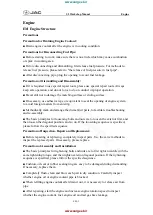
The data is required to perform the control de‐
vice functions. Furthermore, it also serves to
recognize and correct malfunctions, and helps
the vehicle manufacturer to optimize vehicle
functions. The majority of this data is transient
and is only processed within the vehicle itself.
Only a small proportion of the data is stored in
event or fault memories and, if needed, in the
vehicle key.
Reading out data
When servicing, for instance during repairs,
service processes, warranty cases, and quality
assurance measures, this technical information
can be read out from the vehicle together with
the vehicle identification number. A dealer’s
service center or another qualified service cen‐
ter or repair shop can read out the information.
The socket for OBD Onboard Diagnosis re‐
quired by law in the vehicle is used to read out
the data. The data is collected, processed, and
used by the relevant organizations in the serv‐
ice network. The data documents the technical
conditions of the vehicle, helps in locating
faults and improving quality, and is transferred
to the vehicle manufacturer, if needed.
Furthermore, the manufacturer has product
monitoring duties to meet in line with product
liability law. To fulfill these duties, the vehicle
manufacturer needs technical data from the
vehicle. Fault and event memories in the vehi‐
cle can be reset when a dealer’s service center
or another qualified service center or repair
shop performs repair or servicing work.
Data on the scope of servicing work performed
and maintenance records are stored in the ve‐
hicle by means of the service history and trans‐
ferred to the vehicle manufacturer. The vehicle
owner can contact a dealer's service center to
object to the data being stored and transferred
to the vehicle manufacturer. This objection ap‐
plies for as long as the vehicle owner remains
the proprietor of the vehicle.
Data entry and data transfer into the
vehicle
General information
Depending on the vehicle equipment, some
data can be transferred into the vehicle when
using comfort and infotainment functions,
for instance:
▷
Multimedia data such as music, films or
photos for playback in an integrated multi‐
media system.
▷
Address book data for use in conjunction
with an integrated hands-free system or an
integrated navigation system.
▷
Entered navigation destinations.
▷
Data on the use of Internet services.
This data can be stored locally in the vehicle or
is found on a device that has been connected
to the vehicle, e.g., a smartphone, USB stick or
MP3 player. If this data is stored in the vehicle,
it can be deleted at any time. This data is only
transmitted to third parties if expressly desired.
This depends on the personal settings se‐
lected for using online services.
Depending on the vehicle equipment, the fol‐
lowing comfort and individual settings can be
stored in the vehicle and modified at any time,
for instance:
▷
Settings for the seat and steering wheel
positions.
▷
Suspension and climate control settings.
▷
Individual settings, for instance lighting in
the car's interior.
Control via mobile devices
Depending on the vehicle equipment, mobile
devices connected to the vehicle, for instance
smartphones, can be controlled via the vehicle
control elements. The sound and picture from
the mobile device can be played back and dis‐
played through the multimedia system. Certain
information is transferred to the mobile device
at the same time. Depending on the type of
Seite 10
Information
10
Online Edition for Part no. 01402983801 - X/17
Summary of Contents for X5 2018
Page 2: ......
Page 14: ...Online Edition for Part no 01402983801 X 17 ...
Page 36: ...Online Edition for Part no 01402983801 X 17 ...
Page 205: ...Storage compartments Controls 205 Online Edition for Part no 01402983801 X 17 ...
Page 206: ...Online Edition for Part no 01402983801 X 17 ...
Page 222: ...Online Edition for Part no 01402983801 X 17 ...
Page 280: ...Online Edition for Part no 01402983801 X 17 ...
Page 297: ......











































